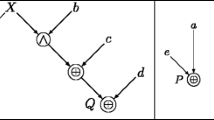Abstract
The r-th order nonlinearity of a Boolean function is the minimum number of elements that have to be changed in its truth table to arrive at a Boolean function of degree at most r. It is shown that the (suitably normalised) r-th order nonlinearity of a random Boolean function converges strongly for all r ≥ 1. This extends results by Rodier for r = 1 and by Dib for r = 2. The methods in the present paper are mostly of elementary combinatorial nature and also lead to simpler proofs in the cases that r = 1 or 2.
Similar content being viewed by others
References
Carlet, C.: The complexity of Boolean functions from cryptographic viewpoint, Complexity of Boolean Functions (Dagstuhl, Germany), Dagstuhl Seminar Proceedings, no. 06111 (2006)
Carlet, C.: Boolean functions for cryptography and error-correcting codes. In: Crama, Y., Hammer, P.L. (eds.) Boolean Models and Methods in Mathematics, Computer Science, and Engineering, pp 257–397. Cambridge University Press, Cambridge (2010)
Dib, S: Distribution of Boolean functions according to the second-order nonlinearity. In: Arithmetic of finite fields, Lecture Notes in Comput. Sci., vol. 6087, pp 86–96. Springer, Berlin (2010)
Feller, W.: An introduction to probability theory and its applications, Third edition, vol. I. Wiley, New York (1968)
Halász, G: On a result of Salem and Zygmund concerning random polynomials. Stud. Sci. Math. Hung. 8, 369–377 (1973)
Kaufman, T., Lovett, S., Porat, E.: Weight distribution and list-decoding size of Reed-Muller codes. IEEE Trans. Inf. Theory 58(5), 2689–2696 (2012)
Knudsen, L.R., Robshaw, M.J.B.: Non-linear approximations in linear cryptanalysis. In: Proceedings Eurocrypt’96, Lecture Notes Comput. Sci., vol. 1070, pp 224–236 (1996)
Litsyn, S., Shpunt, A.: On the distribution of Boolean function nonlinearity. SIAM J. Discrete Math. 23(1), 79–95 (2008/09)
MacWilliams, F.J., Sloane, N.J.A.: The theory of error-correcting codes. Amsterdam, The Netherlands (1977)
McDiarmid, C: On the method of bounded differences. In: Siemons, J. (ed.) Surveys in Combinatorics, London Math. Soc. Lectures Notes Ser. 141, pp 148–188. Cambridge University Press, Cambridge (1989)
Olejár, D., Stanek, M.: On cryptographic properties of random Boolean functions. J.UCS 4(8), 705–717 (1998). (electronic)
Rodier, F.: Sur la non-linéarité des fonctions booléennes. Acta Arith 115(1), 1–22 (2004)
Rodier, F.: Asymptotic nonlinearity of Boolean functions. Des. Codes Cryptogr. 40(1), 59–70 (2006)
Acknowledgments
I thank Claude Carlet for some careful comments on a draft of this paper.
Author information
Authors and Affiliations
Corresponding author
Rights and permissions
About this article
Cite this article
Schmidt, KU. Nonlinearity measures of random Boolean functions. Cryptogr. Commun. 8, 637–645 (2016). https://doi.org/10.1007/s12095-015-0164-3
Received:
Accepted:
Published:
Issue Date:
DOI: https://doi.org/10.1007/s12095-015-0164-3



